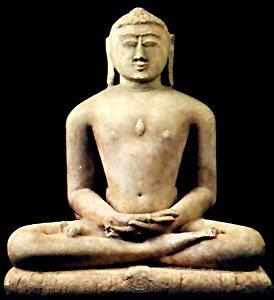 Jain religion addresses the basic question of human existence, its purpose and goal of life. It gives a very strong message that we are not puppets in the hands of some divine power but we can change our fate and make our own destiny. We have cosmic origin which can take different physical forms and identities like trees, animals, human beings, hell beings and God. Knowledge, Awareness and Divinity are our original qualities which are obscured by our physical forms and desire to survive as a body. Increasing the level of self-consciousness by acquiring knowledge about 'Perceived Reality and Truth' of self and this universe, enable us to restore our original self and get a feeling of total bliss.
Jain religion addresses the basic question of human existence, its purpose and goal of life. It gives a very strong message that we are not puppets in the hands of some divine power but we can change our fate and make our own destiny. We have cosmic origin which can take different physical forms and identities like trees, animals, human beings, hell beings and God. Knowledge, Awareness and Divinity are our original qualities which are obscured by our physical forms and desire to survive as a body. Increasing the level of self-consciousness by acquiring knowledge about 'Perceived Reality and Truth' of self and this universe, enable us to restore our original self and get a feeling of total bliss.
Jain religion is all about 'Knowing' and 'Being' - 'Knowing' is science of self and the universe. 'Being' is physical reality as well as spiritual immortality. Unfortunately the interpretation of Jain canonical literature and their critical reviews present Jainism as a faith full of rituals and rigid code of conducts, which is an enigma for rational minds. Further some western and Indian scholars present Mahavir as a reactionary to Vedic concepts. This is atrocious because there is nothing malicious about other religions in Mahavir's teaching. He was not a fundamentalist (Akantwadi) but a hard pluralistic Anekantwadi.
It is well known that Jains do not have one book like Bible or Koran which one can read and learn everything about Jain religion. There are 32 Agamas and innumerable manuscripts, critical reviews and religious manuals written by Acharyas and sages according to their faiths and sectorial understanding.
Our studies of both Swetamber and Digamber literature establishes that the Jain scriptures in fact present modern science in spiritual dimensions, which unfortunately has not yet been brought out in its right prospects till this date. Both Swetambar and Digambar sects are nearly unanimous on the philosophy and science of Jain religion but there are difference in their norms and codes of conduct, rituals and life styles.
All Jain sects essentially believe that knowledge of the self gives the understanding that we are souls- pure consciousness-the witness. Strong emotions and worldly attachments called Karmas obscures the consciousness and creates the feeling of ‘I-am-the body’. If we identify the self with the body, then the self is in the state of delusion and this false identification makes us suffer. We loose our real identity and indulge in such activities which modulate the soul further. The modulated soul then undergoes births and rebirths in which it acquires different types of bodies, the blue print for which exists in its modulated format referred as Karman Sharira.
Jain religion aims at generating thirst for self-realization. It says we exist and our existence is not at the mercy of God. Our existence as soul is Sat i.e. Absolute Truth and our identification with the perishable body, blood, flesh and bones is our false identification caused by our ignorance. If we acquire right knowledge of the self and rest of the world, follow the path of righteous conduct we move in steps from lower to higher states of consciousness.
The process of reducing the delusion and ignorance is slow and evolutionary in nature. It starts at the lowest level of consciousness present in Nigodh (Plankton) and ends at the highest level of human consciousness. The human being can further evolve to a state of omniscience which is also called Kewalgyana or Moksha. All Jain sects believe that Samyag Gyana (Right Knowledge), Samyag Darshan (Right Vision) and Samyag Charitra (Right Conduct) is the path of Moksha.
Jain scriptures describe the universe as Panchastikaya which means existence of five material quantum fields which behave as if made of innumerable atomic size Akash Pradesh. Jivastikaya is one of its constituents which is a potential field of consciousness, awareness, memory, and information. Pudgalastikaya is second constituent which is inanimate and which is physically realised as particles or atoms. Thus Akash Pradesh is equivalent to one atom. Remaining three Astikayas are three different kinds of potential fields which generate motions and also assist in the placement of atoms, molecules and their aggregates in the space.
All the five constituents undergo Space-Time transformations producing different physical forms called Paryaya. The scriptures describe the transformations as Physical Reality or Relative Truth and also state the governing laws which were rediscovered in Europe as laws of physics, biology and chemistry. The five Astikaya Dravyas are potential fields or quantum fields which are respectively realised in space time domain as Consciousness, Pudgal Parmanu, State of Motion State of Rest and Gravitational force. This proves that the Jain Shramans were pioneering quantum physicists.
Jain Agamas are the primary source of knowledge preached by Jain Tirthankars. The verses contain statements made in Vyavahar Naya as well as Nishchaya Naya akin to descriptions of classical phenomena and quantum phenomena. Thus Panchastikaya version of the universe represents 4D and quantum nature of the infinite space and the description that the universe consists of six constituents is a physical realty. The former is subject of cosmology and the later is the field of astronomers who visualize the universe as consisting of galaxies, stars, planets, empty space, celestial junk materials etc.
Our research work published in the form of research papers, articles and books provide unquestionable evidences to prove that the Jain Agamas contain descriptions of law of conservation of mass and energy, quantum nature of matter, biocentrism, biological evolution, quantum atom and laws of chemical combinations as we know them today. Their concepts of Space, Time, Absolute and Relative Truth, Field Unification Theory and even the much hyped God Particle are similar to their modern versions.
No serious attempt has been made so far within or outside the Jain community for providing an authenticate assessment of Jain religion. The history, social customs and spiritual science described by both national and international scholars and critics are apparently based on hearsay and perceived ideas and not on analysis of original Jain scriptures which are hard to understand because of their old extinct language and 'Twitter-like' style. An attempt is being made in this article to present Mahavir's legacy in its true rational and scientific form.
 Dr. M.B. Modi
Dr. M.B. Modi